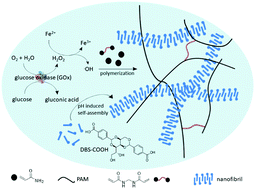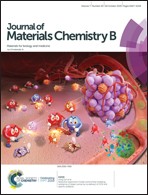One-pot preparation of double network hydrogels via enzyme-mediated polymerization and post-self-assembly for wound healing
Abstract
Hybrid hydrogels combining polymers and low-molecular-weight gelators (LMWGs) are promising soft materials. Self-assembled LMWG-based supramolecular networks via noncovalent interactions exhibit excellent reversible thixotropy, which are usually incorporated into polymer gel networks generating functional double network hybrid hydrogels. In this study, we used enzyme-mediated polymerization and post-self-assembly for the one-pot preparation of LMWG-based hybrid hydrogels which consist of a covalently cross-linked polyacrylamide as the first chemical network and post-self-assembled DBS-COOH as the second supramolecular network. The gelation processes are monitored by the EPR measurement and 1H NMR characterization. The DBS-COOH gel network endows the hybrid gel with a well-controlled release behaviour of an anti-inflammatory drug—diclofenac sodium (DCF). Further in vivo wound healing experiments elucidated that the hybrid gel is a promising candidate material for biomedical applications. The enzymatic one-pot preparation principle will provide a unique viewpoint for fabricating functional LMWG/polymer hybrid hydrogels.



 Please wait while we load your content...
Please wait while we load your content...